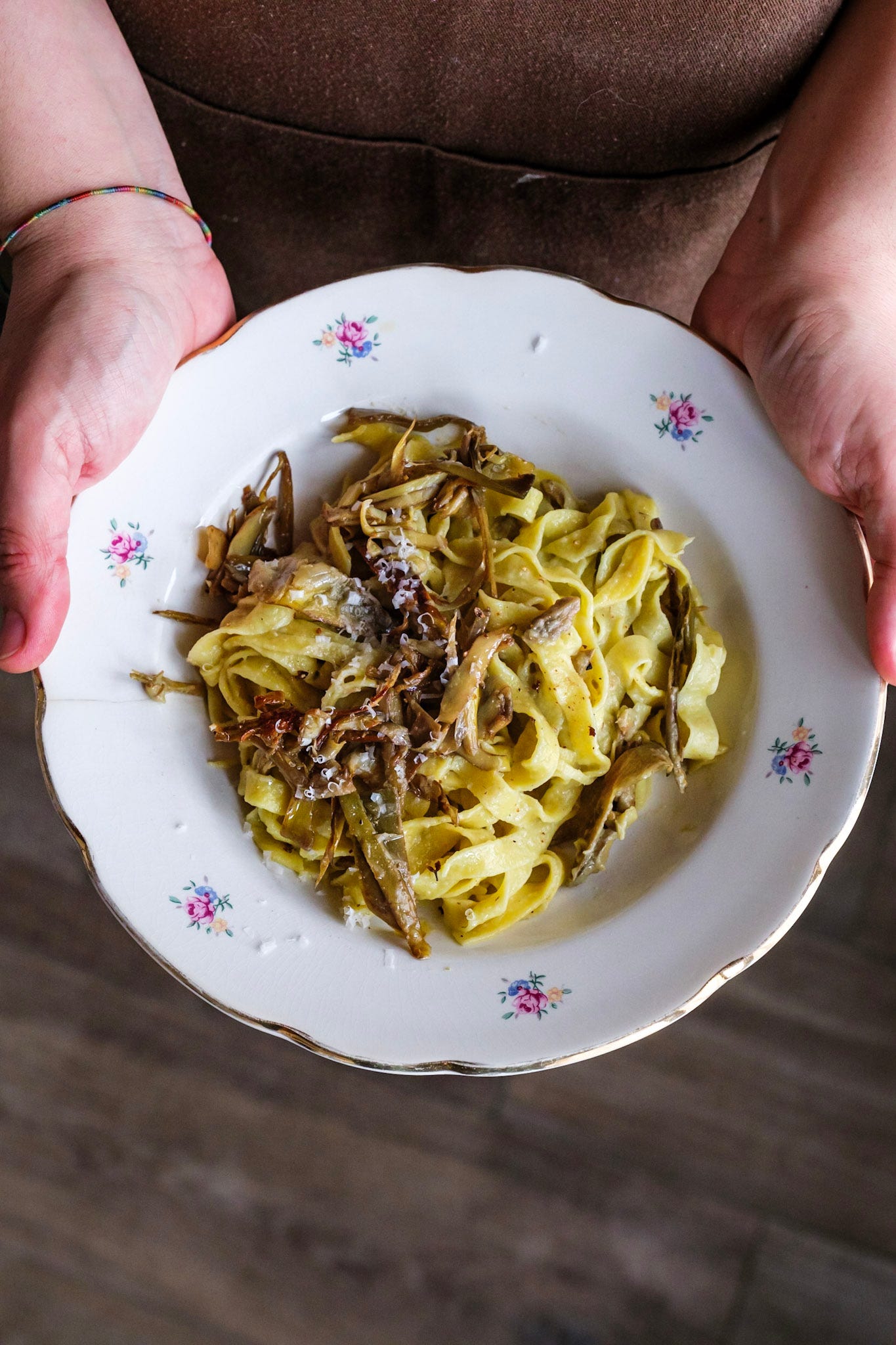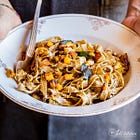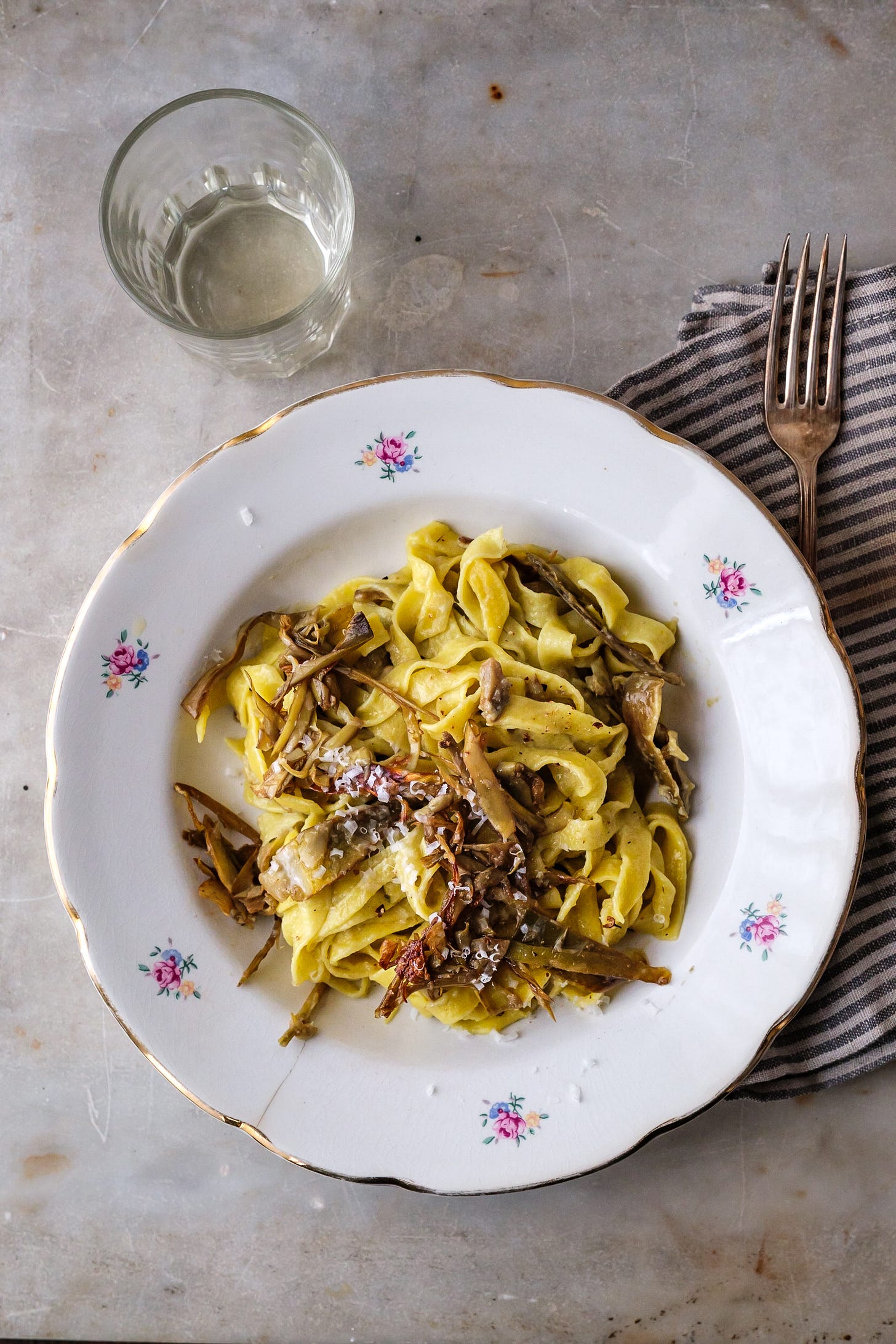Saffron Tagliatelle with Artichokes
I fell in love with the recipe and the flavour combination: saffron and artichokes are a marriage of love.
This is an exclusive recipe for the subscribers. It is part of a serialized Tuscan cookbook that you will receive over the course of one year, a collection of tested classic Tuscan recipes to add to your cooking repertoire. Learn more about the I Love Toscana project here and find all the recipes here. You can upgrade and get access to this, as well as all our monthly cook-along and live talks, on the link above.
The time of multiple-course heavy menus designed to impress is over. It might be because I’m getting older—I’ll be 42 in a couple of months—, and I’m no more able to eat as I used to do in my thirties, or because I feel the need for seasonal menus with a clear purpose, less dishes, and plenty of vegetables.
That’s why I elected this dish the star of a lunch I organized during a bread making course we hosted at the studio: vegetable-forward appetizers to open the meal, a glorious bowl of saffron tagliatelle with artichoke as main course, and a clean strawberry biancomangiare to seal the morning with a sweet note.
I fell in love with the recipe and the flavour combination—saffron and artichokes are a marriage of love—, so I decided to test it in the following weeks during cooking classes, tweaking the cooking times and the amount of the ingredients.
That’s the recipe we eventually came to, just in time before the artichoke season ends.
RECIPE - Saffron tagliatelle
Giving an extra layer of flavour to your fresh pasta is easy, and fun. Saffron is a quick, eye-catching option, but if you are in the mood of experimenting, you could try with porcini, too, as in this archive recipe for dried porcini mushroom tagliatelle (though not with this artichoke dressing!).
I prefer to use the most precious saffron pistils to make risotto, while for the fresh pasta saffron powder works perfectly, as it easily melts in the eggs and gives an even coloring to the pasta dough.
Saffron tagliatelle would work well with a fresh tomato sauce, with zucchini and mint, and with a mussel or seafood dressing.
For the tagliatelle (serves 4 to 6 as a first course)
1 cup/120 g of 0 flour (or all-purpose)
½ cup/ 80 g of semolina flour
2 eggs
1 pinch of saffron
1 teaspoon extra virgin olive oil
1 pinch fine sea salt
Pour the two flours on a wooden board or a large working surface, and make a well in the centre. Make it big enough so that it can fit the eggs.
Break the eggs in a small bowl, beat them quickly with a fork, then add the saffron. Stir until it has melted into the eggs, then add them along with the olive oil, and a good pinch of salt to the flour.
Mix the flour and the eggs with a fork until crumbly.
A dough scraper might be useful, too: scrape the flour, fold onto itself, and chop, and repeat, aiming for big crumbs. Making fresh pasta is fun and messy, and it can be sticky. Using a tool as a fork or a scraper, especially if you are a beginner, is helpful, as you might be tempted to add more flour when you feel the eggs sticking to your fingers. Don’t! Trust the process, and the ingredients, and keep working.
When the flour and the eggs are bind together into big crumbs, use your hands to make a ball, squeezing the crumbs together, then start kneading the dough.
Keep on kneading, more and more, as to develop the gluten which will give strength to the sheets of pasta. Just do as when you knead the bread: hold it with one hand while you roll it from you with the other, with the heel of the palm, then fold on itself and repeat.
After a while, the dough should have the right consistency: smooth, velvety and no longer sticky.
Cover with a bowl and let it stand at room temperature for 30 minutes.
After this time, roll the dough. Whether you’re using a classic long rolling pin or a pasta machine, the most important thing is to roll it over and over again, rolling and stretching it as much as you can.
Make a thin wide sheet of pasta (using my Marcato pasta machine I stop at the 6th mark).
Leave the pasta sheets for about 10 minutes on a board dusted with semolina flour.
Cut the pasta into 1 cm wide strips with the pasta machine or by hand, rolling the sheets up and cutting them with a sharp knife across intro strips.
Spread them all out on a cloth and leave them there until you want to cook them.
Tagliatelle could be prepared a couple of hours in advance, and left at room temperatures, or you can prepare them the day before and freeze them. Wrap them loosely to form a nest and arrange the nests on a tray, cover with plastic wrap and freeze. When the tagliatelle are frozen they can be collected into a plastic ziplock bag and kept in the freezer for up to 2 months. If you cook frozen tagliatelle, plunge them in the boiling water when still frozen, directly from the freezer, and cook them for one more minute.








